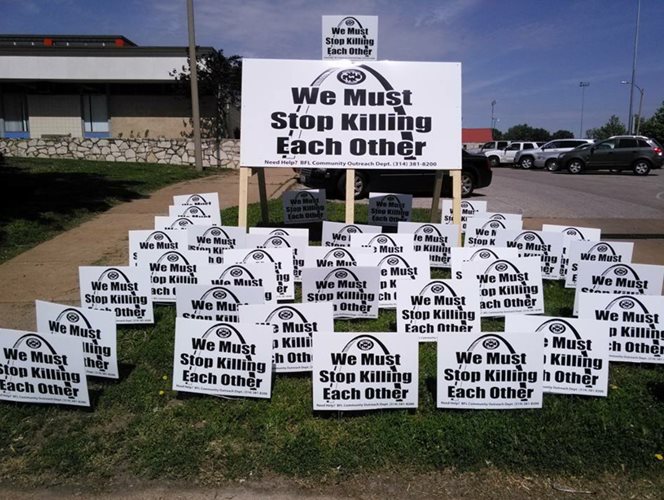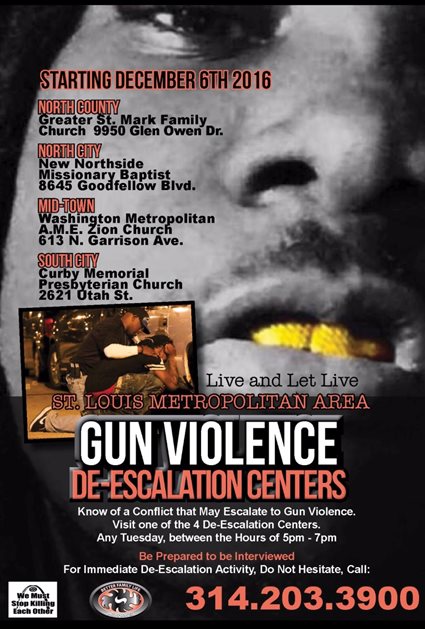
St. Louis was the subject of some tough media coverage in the last few weeks. All of the local news stations carried headlines like, “Homicides, violent crime surging in St. Louis County.” And they are right. According to a study by Washington University, St. Louis has a violent crime rate of 1,857 per 100,000 people—second highest in the United States. And it’s No. 1 for homicides specifically.
Curious about what role community-development organizations can play when their neighborhoods become hot spots, I called James Clark, vice president of community outreach with Better Family Life, a St. Louis-based NeighborWorks network member. He confirmed that gun-related violence has reached a crisis point in his city. But he also went on to tell me about a unique program that shows promise of going a long way toward defusing dangerous tensions before they escalate into crimes.
The crisis
Clark grew up in one of the St. Louis neighborhoods that today are so troubled. It was in the late 1980s and ’90s, he recalls, when gun violence and homicides began their seemingly inexorable climb. Clark attributes that change, seen nationwide, to the rise of crack cocaine and the growth of gangs fed by drug sales.“What was new is this mentality of the streets, a willingness to use violence and even to kill to settle differences. Most residents were firmly against this response, of course; but they were silent, whether out of fear or a feeling of hopelessness,” explains Clark. “The answer can’t be just better policing; we need to help by doing what we can ourselves to reduce the violence and illegal activity.”
De-escalation
 It is in this space where Better Family Life hit on a unique and highly successful grassroots model, which Clark believes can be replicated in many other “hot spots” across the country: gun violence de-escalation centers.
It is in this space where Better Family Life hit on a unique and highly successful grassroots model, which Clark believes can be replicated in many other “hot spots” across the country: gun violence de-escalation centers.The inspiration came almost by happenstance. About a year ago, in response to the growing gun violence in the area’s communities, Better Family Life distributed yard signs saying simply, “We Must Stop Killing Each Other: Now is the Time.” The sentiment sparked an avalanche of support; the first batch of 50 signs was snapped up in just 30 minutes. At every door Clark’s team knocked on, the residents said yes! Cars even pulled over, with the drivers saying they wanted one too. Today, about 14,000 such signs dot yards and public spaces throughout the metro area. The nonprofit’s initiative also started generating calls for help.
“The callers told us about relatives or friends who were having a conflict with someone else—maybe over a girlfriend or even just a broken window. And the callers knew that when the two came into contact with each other next, there would be gunplay,” Clark recalls. “We have a staff of outreach workers from the neighborhoods trained in conflict mediation, so we helped de-escalate the situation. After the third such call and successful intervention, we realized we had stumbled onto a real need and a model that worked.”
With the help of the faculty at nearby Washington University, Clark and his team formalized the process by mapped it using a logic model. Then they reached out to churches in the most challenged neighborhoods to host “de-escalation centers.” Today, there are two fully funded locations open 9 a.m. to 5 p.m., supplemented by a 24-hour hotline staffed for now by Clark and a colleague. (Clark carries his mobile phone with him everywhere, prepared to take a call even when at the gym.) However, the goal is to open a center in all 12 of the neighborhoods identified in the P.I.E.R. (Prevention, Intervention, Enforcement and Reentry) plan for St. Louis, as well as in other surrounding neighborhoods. To date, 21 crises have been de-escalated, and Better Family Life is averaging five to seven calls a week. As a result, the crew of trained outreach workers is increasing from seven to 12.
 “Outreach workers must be from the neighborhoods,” warns Clark. “To catch a wolf, you need to hire a wolf. You can’t learn this kind of thing—the mannerisms and other nonverbal cues—on a college campus.”
“Outreach workers must be from the neighborhoods,” warns Clark. “To catch a wolf, you need to hire a wolf. You can’t learn this kind of thing—the mannerisms and other nonverbal cues—on a college campus.”Here is how it works:
- Anyone who knows about a conflict brewing can call or drop in. With 80 percent of shootings, says Clark, there is a third party who knows the conflict exists and is likely to escalate, but can’t go to the police because that would be “snitching.” Clark’s team gets moving immediately. “There’s no time for pleasantries. Crimes occur without warning and fast, so we try resolve evolving crises within 72 hours,” he explains.
- The first step is to create a “phone tree”—names and contact information for anyone who could credibly intervene with the potential assailant, helping to bring him or her to the team for negotiations. It could be a mother, a sibling, a girlfriend, even a favorite basketball coach. “The targeted person first gets calls from the people who care about him, or who he cares about. We often then get a call from him saying, ‘You got my grandmother worried, man’.”
- The team working on each case includes an outreach worker and a clinical therapist, recruited through the Association of Black Psychologists. The therapist asks direct questions about drug addiction and mental illness that might pre-dispose the adversary to violence, then makes referrals if necessary. Better Family Life also is prepared to help the targeted person find employment, enroll in a GED class or plug into other social service to address root causes contributing to frustration and violence. “Some adversaries even end up thanking the party who brought us in, because of the support and services they get,” says Clark.
The bottom line: Most neighborhood crimes are not committed by professional thugs, and community leaders can be a stabilizing force.
“People tend to believe people who commit crimes like homicide are prone to gun violence—hell-bent criminals looking only to kill,” says Clark. “But 80 percent of the time, these are really just people who believe their adversary is coming after them or that there is no other solution to a conflict. In most cases, both sides would rather de-escalate, to find a way out. In fact, they are relieved.”

